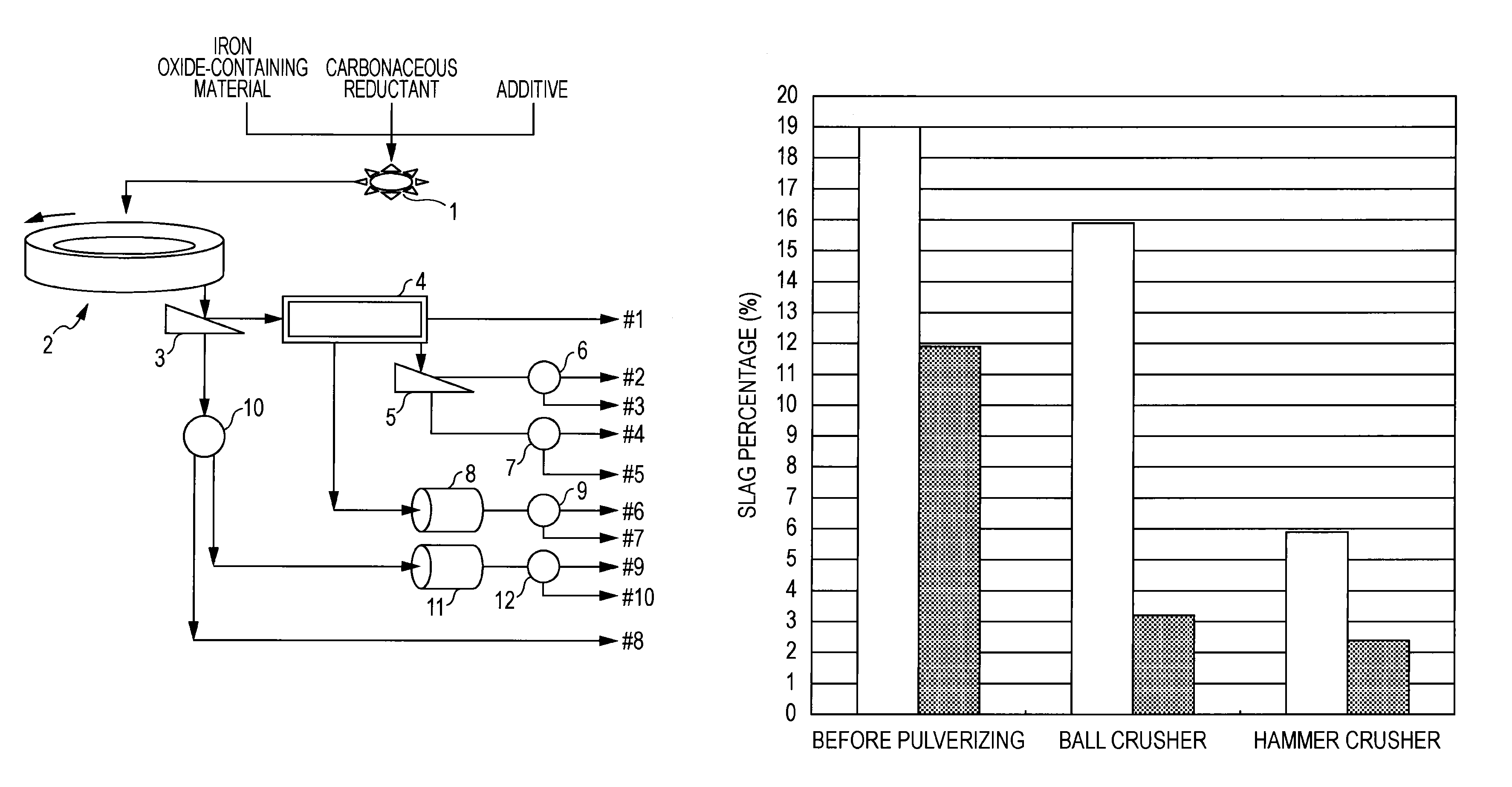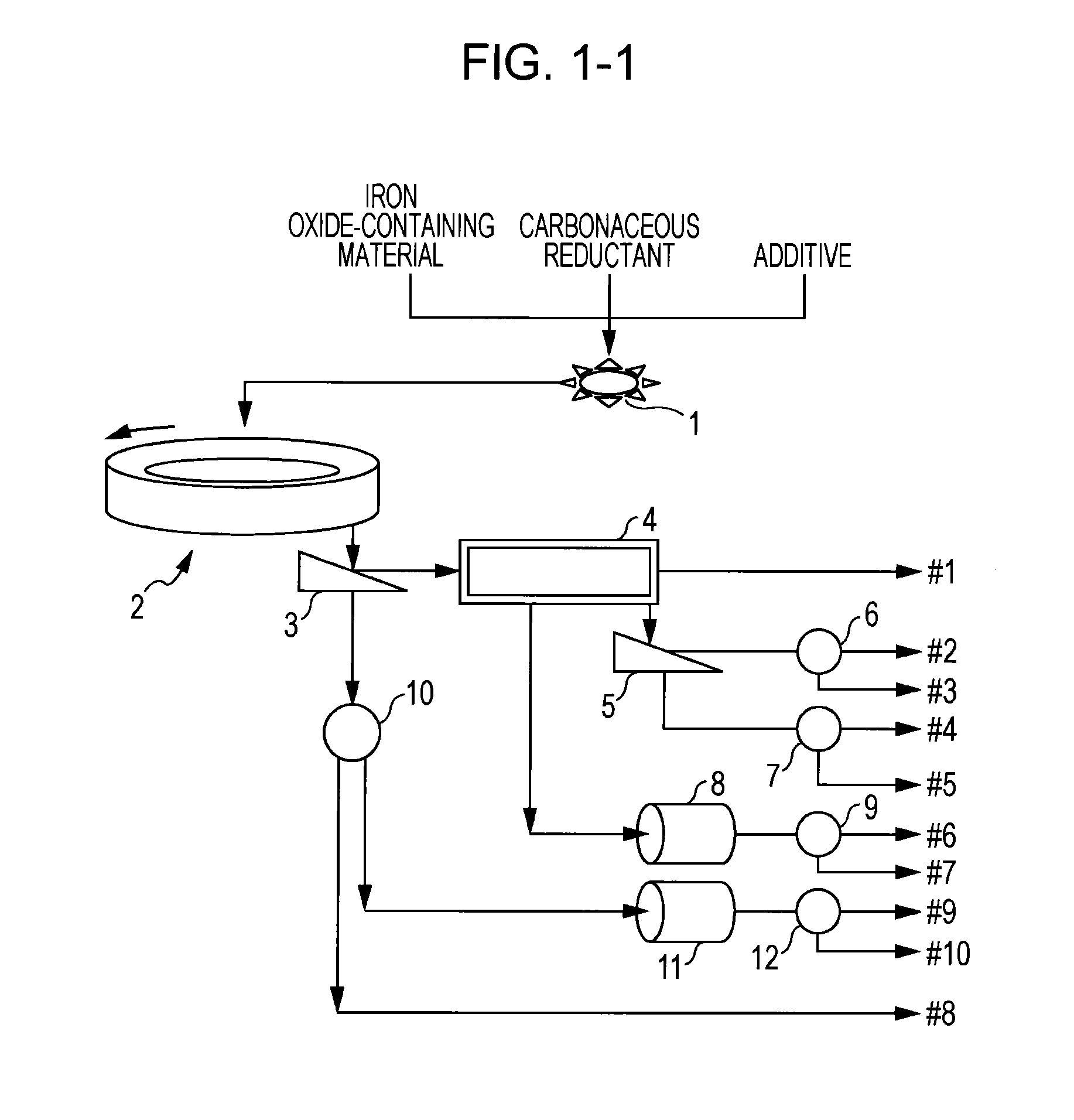Method for producing metallic iron
a technology of metallic iron and production method, applied in the direction of gas current separation, electric furnace, furnace, etc., can solve the problems of increasing energy and difficult use in electric furnaces or blast furnaces, and achieve the effect of efficient separation, efficient collection and efficient separation
- Summary
- Abstract
- Description
- Claims
- Application Information
AI Technical Summary
Benefits of technology
Problems solved by technology
Method used
Image
Examples
first modification
[First Modification]
[0397]When heating the agglomerate in a movable hearth type heating furnace, there are cases where the metallic iron melts on the hearth and joins with nearby metallic iron and forms large clumps. In the same way, there are cases where slag melts on the hearth and joins with other nearby slag and forms large clumps. Slag forming large clumps is crushed during discharge from the heating furnace and subsequent handling, and thus is broken down into finer pieces. However, the metallic iron forming large clumps is not broken down into finer pieces, and remains in large clumps. Supplying the large clumps of metallic iron to the crushing process places a load on the crusher, leading to marked wear on the crusher.
[0398]Accordingly in the first modification, as illustrated in FIG. 3-3, the reduced product which is the discharged matter from the movable hearth type heating furnace 101 is screened using the sifter c having a sieve opening of 15 to 20 mm (105 in FIG. 3-3). ...
second modification
[Second Modification]
[0399]When the agglomerate is heated in a heating furnace at 1300° C. or hotter, hearth covering material such as carbonaceous particles, heat-resistant particles, and so forth may be laid on the hearth of the heating furnace for protection. The suitable granularity of the hearth covering material is said to be 0.5 to 3 mm, meaning that the material is small particles. This hearth covering material is discharged from the heating furnace along with the reduced matter after having heated the agglomerate. Accordingly, the medium particles which have passed through the sifter c in the above-described screening process c (undersieve c) include the hearth covering material.
[0400]Accordingly, in the second modification, as illustrated in FIG. 3-3, the reduced product discharged from the movable hearth type heating furnace 101 is screened using the sifter c having a sieve opening of 15 to 20 mm (105 in FIG. 3-3), and the medium particulate material which has passed thro...
third modification
[Third Modification]
[0401]In the third modification, the medium particulate matter collected as undersieve c on the sifter b may be sorted at the magnetic separator (107b in FIG. 3-3), thereafter supplied to the crusher 102 via an unshown path, and the magnetically attractable substance crushed by application of impact, as described above. The collecting efficiency of metallic iron obtained by crushing the magnetically attractable substance can be improved by sorting the magnetically non-attractable substance by a magnetic separator beforehand.
[0402]Also, the medium particulate matter collected as undersieve c on the sifter b may be sorted at the magnetic separator (107b in FIG. 3-3), the magnetically attractable substance thereafter supplied to the pulverizer (108b in FIG. 3-3), pulverized, and select the magnetically non-attractable substance by the magnetic separator (107e in FIG. 3-3) beforehand, thereby improving the collecting efficiency of metallic iron (104b in FIG. 3-3) obt...
PUM
| Property | Measurement | Unit |
|---|---|---|
| density | aaaaa | aaaaa |
| temperature | aaaaa | aaaaa |
| grain size | aaaaa | aaaaa |
Abstract
Description
Claims
Application Information
 Login to View More
Login to View More - R&D
- Intellectual Property
- Life Sciences
- Materials
- Tech Scout
- Unparalleled Data Quality
- Higher Quality Content
- 60% Fewer Hallucinations
Browse by: Latest US Patents, China's latest patents, Technical Efficacy Thesaurus, Application Domain, Technology Topic, Popular Technical Reports.
© 2025 PatSnap. All rights reserved.Legal|Privacy policy|Modern Slavery Act Transparency Statement|Sitemap|About US| Contact US: help@patsnap.com



